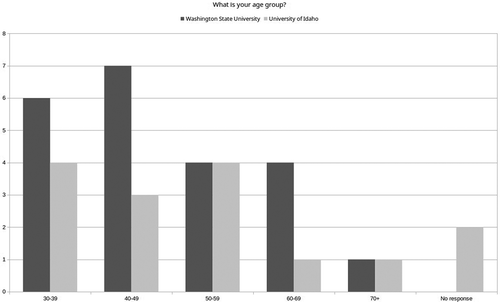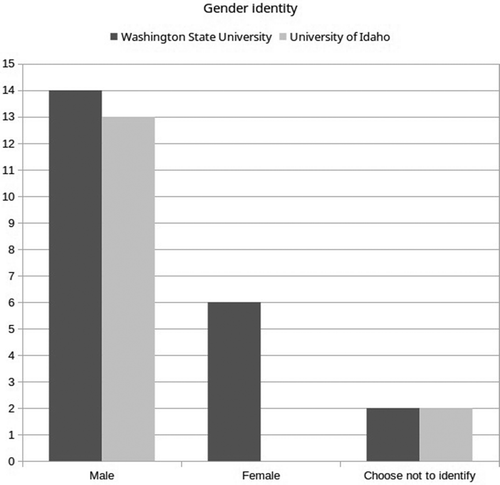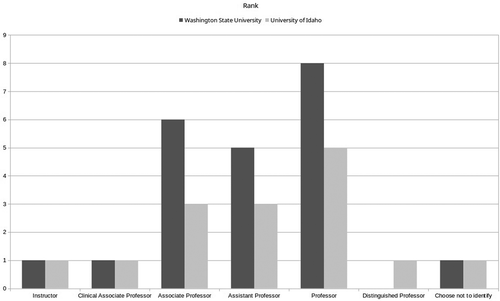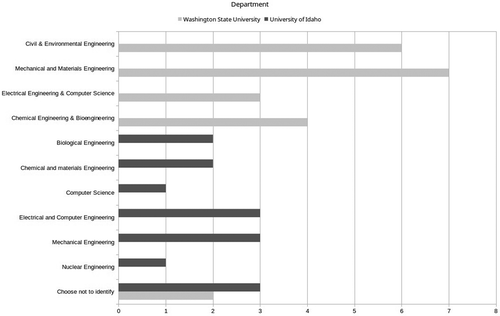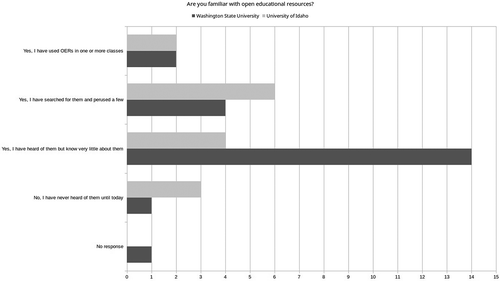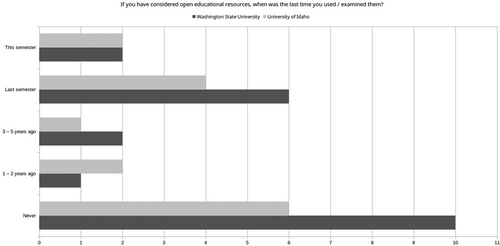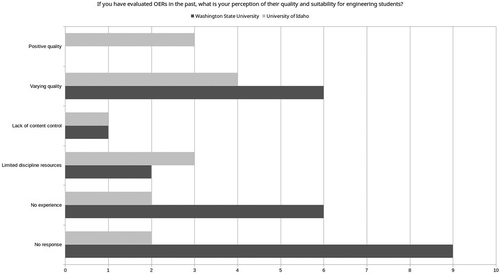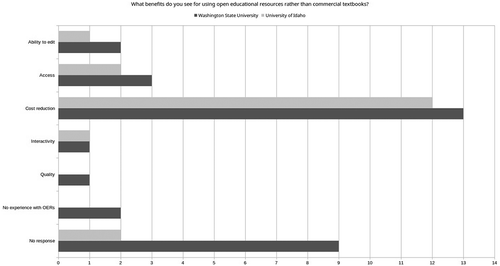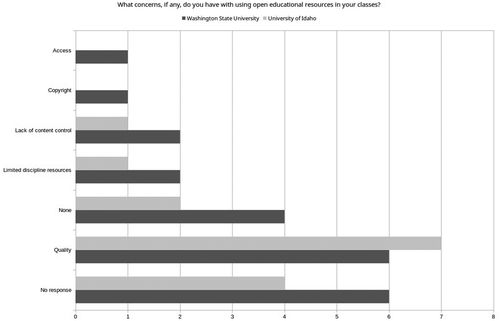ABSTRACT
As open education initiatives aiming to lower the cost of course materials appeared at two universities, librarians became involved in identifying open educational resources (OERs) for university courses. However, when considering a number of subject areas—particularly in colleges focused on upper-division instruction—librarians encountered problems related to the availability of resources and materials selection processes. For this project, librarians selected one prominent subject area at their respective institutions—engineering—and worked to identify best practices for introducing OERs into courses. They surveyed engineering faculty and instructors to better understand their perceptions and needs related to OERs and, based on this work, they suggest best practices for liaison librarians in specialized fields who wish to incorporate OERs into their outreach work with a focus on upper-division courses.
Introduction
In 2016, the Associated Students of Washington State University (ASWSU) put forward a Course Materials Cost Reduction Initiative (ASWSU, Citation2015), calling on instructors and administrators to identify strategies for reducing students’ financial burden. Among other things, the students recommended creation of a university task force to consider the issue, introduction of an open source program, faculty education on the cost of course materials, and standardization in the use of quick-response systems (clickers, etc.) (ASWSU, Citation2015). In response to this statement by ASWSU, the WSU Provost’s Office established a task force, which evolved into a steering committee that recommended, among other things, the increased use of open educational resources (OERs) on campus (Course Materials Cost Reduction Presidential Task Force, Citation2016).
Similar efforts began at the University of Idaho (UI) in 2014 as librarians and the Associated Students of the University of Idaho (ASUI) began awareness-raising campaigns about the high cost of textbooks and the availability of low-cost or free open source alternatives. In 2015, the University of Idaho library started a student-driven course reserves pilot in order to increase the number of textbooks available on reserve, and in early 2017 a pilot mini-grant fellowship program awarded five faculty fellows small grants to support transitioning courses to using OER (University of Idaho Library, Citation2017).
As part of these cost reduction efforts at both Washington State University and the University of Idaho, each school’s respective Scholarly Communication Librarian and Engineering Liaison Librarian became involved in identifying low-cost, high-quality resources that could prove suitable for adoption in engineering courses. We soon encountered difficulties—most notably that few resources existed for specialized upper-division courses. In a further complication, we also learned that the departments in our respective Colleges of Engineering select course materials quite differently, with some channeling all selections through curriculum committees while others devolve responsibility entirely to individual professors. The variability in selection methods made outreach efforts more difficult, as some departments pointed to committees and others to individuals to make decisions about the use of OERs. After making these discoveries, we decided to investigate further to learn more about the course material needs of engineering faculty at our respective institutions. We surmised that other liaison librarians serving disciplines with a focus on specialized, upper-division courses—typically areas with fewer OER options—could particularly benefit from observations collected through surveys and interviews.
It must be noted that the recent interest in open educational resources at WSU and UI is not unique to these schools. Open education has been a growing trend throughout the 2000s, since the phrase was introduced by the United Nations Educational, Scientific, and Cultural Organization in 2002. As defined by UNESCO (Citation2017), OERs are “teaching, learning or research materials that are in the public domain or released with an intellectual property license that allows for free use, adaptation, and distribution.” OERs have been implemented in programs ranging from MIT’s OpenCourseWare to Carnegie Mellon’s Open Learning Initiative and Rice University’s Connexions and OpenStax textbooks (Atkins, Brown, & Hammond, Citation2007; Sclater, Citation2010; Smith, Citation2009). Universities and community colleges have increasingly offered incentives for instructors to adopt OERs in order to improve student access to course materials (SPARC, Citation2017). Due in part to these initiatives, OERs have entered the market as true players in course material selection. To cite one statistic, OpenStax (Citation2017) reported that students have saved more than $155 million since 2012 by using the organization’s open textbooks.
As open education has built momentum, libraries have quickly rallied in support. Projects like Open Textbook Library, BCcampus, Open SUNY, and MERLOT have invited librarians to use their cataloging, organizational, and outreach skills to assist faculty members and students in finding and evaluating open educational resources (BCcampus, Citation2017; MERLOT II, Citation2017; Open SUNY, Citation2017; Open Textbook Library, Citation2017). Numerous papers have emerged that call on librarians to support open education by developing their knowledge of open pedagogies and open access publishing, increasing outreach to faculty members, developing capacity for library publishing, and building and maintaining repositories of open content (Bell, Citation2015; Jensen & West, Citation2015; Mitchell & Chu, Citation2014; Okamoto, Citation2013; Pitcher, Citation2014; Sutton & Chadwell, Citation2014). Top-down support for open education is also growing in professional library organizations. In its white paper on the “Intersections of Scholarly Communication and Information Literacy,” the Association of College and Research Libraries (ACRL) suggests instruction and liaison librarians need to understand open access publishing because they are constantly “teaching informally and formally about the changing nature of scholarship and art in the digital world” (ACRL, Citation2013, p. 13). The paper advocates integrating discussion of scholarly communication (including open access publishing) into workshops, faculty meetings, online instructional materials, and campus committee meetings, while remaining cognizant of “disciplinary differences” across programs (ACRL, Citation2013, p. 19). This guidance from ACRL adds another dimension to the work of liaison librarians, as identified in the literature of embedded and liaison librarianship (Andrews, Citation2015; Kvenild, Citation2012; Shumaker & Makins, Citation2012).
While library interest in OERs continues to grow, previous research suggests faculty perceptions of OER may differ in significant ways. The literature has identified altruistic, commercial, and transformational incentives that motivate faculty members to make use of OERs (Sclater, Citation2011). On the other hand, OER use presents teaching faculty with challenges around copyright, quality, sustainability, interoperability, technical demands, cultural and language barriers, cost, exploitation of labor, and lack of institutional policies and incentives (Geser, Citation2007; Hylén, Citation2006; Matkin, Citation2010; Pena, Citation2009; Sclater, Citation2011; Yuan, MacNeill, & Kraan, Citation2008). These incentives and challenges have been presented in a number of seminal studies. For instance, studies conducted in 2008 and 2010 revealed that faculty members at Tufts and various schools in California had reservations about using OERs due to perceived lack of content quality, time pressures, and loss of compensation for authors (Harley, Lawrence, Acord, & Dixson, Citation2010; Lee, Albright, O’Leary, Terkla, & Wilson, Citation2008). Drawing on these results, the organizers of the 2010 survey concluded, “Faculty are independent thinkers, exceptionally busy, suffer from extreme information overload, are generally dedicated to ensuring their students’ success, and do not take well to ‘one size fits all’ solutions” (Harley et al., Citation2010, p. 4).
Later surveys revealed more neutral or positive responses to OERs. A Florida Virtual Campus survey in 2012 found that three-quarters of some 2,500 faculty respondents had heard of OERs and were likely to use them in the future (Donaldson, Nelson, & Thomas, Citation2012). In 2016, the Babson Survey Research Group collected responses from more than 3,000 faculty members, 31.3% of whom stated that they would consider using OERs in the next 3 years (Allen & Seaman, Citation2016). A 2014 survey of 1,637 faculty members at 56 universities in Turkey also found that faculty perceived OERs in a positive light, but had concerns about quality and IP protections for authors (Kursun, Cagiltay, & Can, Citation2014). Finally, in 2016, John Hilton, III reviewed five of the largest perception studies to date and concluded that a “strong majority” of instructors “believe OERs are as good or better than traditional textbooks” (Hilton, Citation2016).
While these large-scale surveys are helpful in uncovering general trends in open education, little work has been done to assess discipline-specific attitudes toward OERs. Thus far, discipline-specific work includes a survey conducted in 2005, presenting reasons why faculty at MIT—including engineering faculty—did not choose to participate in MIT OpenCourseWare. Stephen Carson (Citation2005), the author of the resulting report, found that 75% of all faculty at MIT had opted to publish their courses and that the remaining 25% chose not to participate due to concerns about quality, requisite time investment, copyright, and the future marketability of material published openly. Although this report does not speak exclusively to the motivations of engineering faculty, it does reveal perceptions of faculty at an institution with a large number of engineering courses. Similarly, in a special issue of IEEE Transactions, editors Edmundo Tovar and Nelson Piedra presented the experiences of engineering faculty who had used OERs. Tovar and Piedra (Citation2014) pointed to examples of successful OER use to note that the quality of open resources should be “considered relative to the target audience” (p. 217). In keeping with this argument, instructors in the issue discuss how they used OERs to advance curricula, engage students in the creation of materials across a range of skill levels, and support students who frequently miss class (Ackovska & Ristov, Citation2014; Llamas-Nistal & Mikic-Fonte, Citation2014; QingHua, WeiHua, ZheZhi, & RongHua, Citation2014; Raman, Achuthan, Nedungadi, Diwakar, & Bose, Citation2014).
While studies by Carson (Citation2005) and Tovar and Piedra (Citation2014) are helpful in understanding the general perspectives of engineering faculty on OERs, we determined that a better grasp of the local context would be helpful in supporting current campus initiatives at Washington State University and the University of Idaho. A point frequently reiterated in the literature on embedded librarianship is that libraries must establish strategic partnerships with programs and faculty members in order to effectively advance the liaison program (Andrews, Citation2015; Kvenild, Citation2012). At WSU, the Scholarly Communication and Engineering Liaison Librarians applied this practice by consulting with the Associate Dean of Undergraduate Education in the College of Engineering before speaking to faculty members about OERs. The associate dean identified gateway courses in the college where OERs could make a significant impact on students. He also described departmental culture and practices for selecting course materials, including the use of curriculum committees. This conversation provided a framework for developing a survey of engineering faculty, in keeping with the practices of embedding, which emphasize partnership between libraries and academic disciplines. In order to expand our understanding of engineering faculty needs, we repeated the previously developed survey at the University of Idaho, with the assistance of the Scholarly Communication and Engineering Liaison Librarian at this school.
By surveying and interviewing faculty from the College of Engineering at WSU and UI, we hoped to contribute to a discipline-specific understanding of faculty attitudes toward OERs that will help develop best practices for liaison librarians working in engineering and STEM fields. Ultimately given the growing campus interest in course material cost reduction, this study worked to achieve the following outcomes:
Gauge the understanding and perceptions of engineering faculty members and instructors with regard to OERs in order to structure library outreach activities.
Analyze survey results in order to disseminate best practices for OER outreach.
Open educational resources’ survey of engineering faculty and instructors
To gain insight into faculty understanding of OERs, we developed an online survey distributed to all College of Engineering faculty, clinical faculty, and instructors at Washington State University (see appendix materials for the full survey instrument). The survey was opened at the end of the fall semester 2016, and once again at the beginning of the spring semester 2017, to provide a variety of opportunities for faculty to respond. In order to gather more data and the potential for comparison between institutions, we used the same survey instrument at the University of Idaho. The second survey was open during the middle of spring semester, 2017, and distributed via a variety of email channels. During the development of this research, we petitioned for and received exempt status from the WSU IRB following review by the Office of Research Assurances. Permission was also secured from the University of Idaho, ensuring that we were in compliance with the regulations of both universities.
The survey was distributed to a total of 266 engineering faculty and instructors (168 at Washington State University and 98 at the University of Idaho) and received an overall response rate of 14% (22 at Washington State University and 15 at the University of Idaho). While these responses are by no means neither considered comprehensive nor are representative of all engineering faculty, the completion rate benefitted from the existing relationships and communication channels between the liaison librarians and the respective Colleges of Engineering.
As might be expected given the demographics of both Colleges of Engineering, the respondents were all over 30 years of age and 73% identified as male. The demographic breakdown of the respondents is summarized in and by age and gender identification, by faculty or instructor ranking, and by department or school within each College of Engineering.
To determine basic familiarity with OERs, we included two multiple-choice questions in the online survey. The first asked how familiar study participants were with OERs. Response options ranged from no familiarity to having used an OER in a course (results shown in ). The majority (59%) reported little or no familiarity with OERs. The second multiple-choice question asked study participants to indicate when they had last used or evaluated OERs, if they had ever done so in the past. Approximately 43% of respondents indicated that they have never used or examined OERs. Other respondents indicated that they had used OERs relatively recently, with 38% having done so in the last two semesters, as illustrated in .
Our online survey concluded with four open-ended questions that asked faculty to reflect on their students’ response to OERs, the overall quality of OERs, the suitability of OERs for engineering courses, the benefit of OERs as opposed to commercial textbooks, and any concerns regarding OER use in engineering courses. Responses to these open-ended questions were placed in categories using inductive coding. Note that not every respondent answered all of the open-ended questions. These non-responses are reported in the following figures as “no response.”
In response to the first open-ended question regarding student responses to OERs, the majority of respondents indicated they had no experience with OER so had no student evaluations to report. Some responses were short and cryptic but indicated a positive sentiment, such as “The students like them,” “Fine,” or “Good.” Others provided more complex assessments of student textbook usage that may have little to do with OER. For example: “Students rarely read the book unless there are problems assigned and the book has a template to solve them” and “Some may like it. Most probably prefer walking in my office and ask[ing] whenever they are stuck.”
Other respondents noted that students value the content of OERs above all. For instance, one instructor commented that students “appreciate the ability to get the concepts presented to them by two different viewpoints”—a potential benefit for courses where OERs are listed as recommended supplementary resources. Another respondent remarked that “Students prefer being given short, focused information, as opposed to a textbook,” and another concluded that “Students appreciate having the material for free …but, of course, the quality of the content is the important thing. Who cares if it’s free if it’s also awful?” More than one response highlighted the potential of using open education to support students with various learning styles, including students who may not respond well to traditional textbooks and the typical presentation format in such books.
The responses to this question were coded to characterize the student reactions to OERs using the following categories: No prior experience with OERs, general positive response to OERs (“liked” them), positive response to the low cost of OERs, other perspective, and no response. It is worth noting that only 22% of the faculty reported a positive response. The full breakdown is illustrated in .
Our second free-text question asked faculty about their perception of the quality and suitability of OERs they have evaluated in the past. Responses included negative sentiments such as “Marginal quality,” “Sub par quality at best,” and “Quality is low making them unsuitable for use in the classroom.” Positive responses included, “They vary and some of them are of high quality” and “I developed them so I think they are good quality.” Importantly for this discussion, one faculty member rightly noted that it is difficult to judge the universal suitability of OER since “quality” is such a vague concept and could include many different things. All responses were coded into general categories, presented in .
Many responses about suitability surfaced challenges that often prevent OER adoption. For example, one faculty member said that OER are generally good, but that “there is always a need to do some class customization and the process for doing this is often unclear,” pointing to the obstacles faculty face when trying to adapt OER to their courses. Another survey respondent indicated that the conversation about course materials has shifted “because the students don’t consider quality as the primary value in an information resource; convenience and ability to share are primary.” This respondent concluded that the evaluation of information is the main disconnect between faculty and students regarding course materials. Another stated, “I have some students watch youtube [sic] class videos recorded by some professors, and they got lost and end up confusing themselfs [sic] and making mistakes.” This remark points again to challenges in effectively adopting and adapting OERs for use in courses.
An additional concern frequently noted by survey respondents is the difficulty of finding engineering OERs—a problem that we also encountered while preparing for conversations with instructors. As one faculty member noted, “[I] have seen little that’s out there in the way of engineering material in general and upper-division engineering material in particular.” Lack of relevant resources for their courses was a common deterrent, with respondents noting, “Nothing pertinent has been found to be available,” “They did not cover the topics I needed at the time,” and “I was not impressed with the choices.” However, opportunity exists for using introductory-level materials from other fields, as one faculty member reported, “I use [OER] to teach biology/physiology to [engineering] students.”
In our next open-ended question, we asked faculty members and instructors to reflect on the benefits of OER materials over commercial textbooks. As expected, responses overwhelmingly noted a cost savings for students as the main benefit of using OER (about 68%, see ). Some faculty elaborated on this point. For instance, one noted, “The amount of material in my OERs would bankrupt students if they had to buy books,” while another indicated that OERs can reduce costs by inviting instructors to identify the true needs of a course. Thus faculty members can “reduce costs for students and provide ‘right sized’ material.”
As another benefit of open educational resources, several respondents spoke to the format and characteristics of OERs themselves, noting that open materials facilitate inclusion of more practice problems, interactive problem-solving, searchable content, updated materials, and peer support for fellow students. In this vein, one respondent indicated that OERs solve an all-important access problem for students:
All students should have required course material from the very start of class. Anything less than that compromises their chance for success and that, in turn, compromises the overall course environment. OERs remove the primary impediment to student access to the material.
Other respondents were more neutral or conflicted in their evaluation of OERs as opposed to commercial texts. One questioned whether textbooks were of value at all:
Obviously, [the] current generation do[es] not like to read textbooks. They do not read the textbook they have for the class. I am not sure how online/open sources would be more beneficial. They might be useful for them to learn beyond what we covered in face to face lectures.
One instructor acknowledged the reduction to student cost inherent in open education but remarked on the added time and expense needed to support faculty/instructors who review, create, and customize materials. Overall, while many agreed that OERs could be beneficial, some commented that commercial textbooks are a superior choice for certain topics and additionally can serve as a reference after graduation. Since few respondents identified benefits except cost reduction, it may be important to increase awareness about the many other potential benefits of OER. While focusing on reducing costs is an easy sell on campus, other benefits such as interactivity and customizability may be more compelling to faculty in the long run.
Our last open-ended question asked survey participants to indicate concerns they have with using OERs in courses. A summary of the concerns coded into basic categories is presented in . Responses ranged from little concern because all materials need to be vetted anyway, to the reoccurring concerns for the content’s quality, pertinence, and consistency. As an example of responses to this question, one full professor indicated no concerns about OERs, suggesting that an individual evaluation of course material is more important than the authority of the author writing the materials. Another faculty member noted that “[OER] need to be vetted by subject experts” while another indicated that he vets the materials himself and therefore has no concerns about them. On the other hand, several faculty members pointed to a lack of quality in OERs authored for their specialized areas of teaching.
Overall, quality was the largest concern to faculty and instructors, reported by about 41% of survey respondents when coded to basic categories (see ). Other concerns included limitations in student Internet/computer access, student inability to evaluate sources, problems with copyright/intellectual property, and lack of control over the content. Additionally, several faculty seemed uncomfortable changing their teaching practices to accommodate using OER. For example, one noted that the “style I am teaching may not really match the way available through OERs,” and added concerns about digital learning in general:
Often times I have open book examinations because the material is quite complicated and not easily memorized/used in small chunks. I am worried that having an OER during an examination would allow the student an easy ability to cheat and access material outside the classroom. Generally open educational resources are digital texts. There is something that is lost in the brain (at least for me, and my observations confirm) by using a digital textbook via a digital device. I have taken 3 classes using only a digital text, and the results were not as good as those with hard copy books.
In contrast to this remark, one faculty member cited a benefit of OERs in this section of the survey, returning to the idea of providing students with an alternative perspective on the course topic. The respondent noted:
I often use an OER that is more theoretical than what [is] present in class to encourage the class’s top performers to learn more. On the other hand, I often find OER materials that cover pre-requisite material so that students who are behind can get caught up without having to spend office hours with just those few students.
This response highlighted a theme that appeared more than once on the survey—even if faculty members were uncomfortable with open educational resources, they could imagine using them as supplementary resources for students who might otherwise have little access to meaningful course content.
After completing the surveys described above, we reflected on the setup of the survey and the responses it inspired. If the survey were to be recreated for another department or institution, we would recommend that other researchers consider the language used in the survey in light of the departmental or institutional culture in question. For instance, based on our institutions’ respective cultures, we felt that the use of the phrase “open educational resources” was appropriate in the survey. However, if conversations about open educational resources had been limited, we might have used terms like “reduced-cost materials” or “free course materials” in our survey. Additionally, for others who may be interested in recreating this study, we would like to emphasize the importance of survey length. We intentionally limited the questions—and more specifically the open-ended questions—to encourage participants to complete the survey and provide thoughtful answers. We feel that a longer survey would be likely to dissuade faculty and instructor participation and would advise other researchers to consider this point as well.
Best practices and implementation
Through the survey with faculty and instructors, we have developed best practices for OER outreach and a plan for implementation of OERs in discipline-specific fields (Box 1). Many of these recommendations are mere extensions of the practices that have been posited for embedded and liaison libraries, applying collaborative and outreach strategies to emerging trends in education. These recommendations also seek to further the practices presented in ACRL’s white paper on the intersections of scholarly communication and library instruction (2013).
For liaison librarians making outreach plans, we would recommend that they begin by reviewing available OERs for the discipline in question. Some disciplines are far better represented in the corpus of open educational resources, and instructors in those areas may be more receptive to the idea of open education because they can see concrete examples in practice. Where OERs are not available, liaison librarians may want to initiate a conversation with department administrators about possibilities for developing resources programmatically, perhaps with the support of a course fee. For instructors who are dissatisfied with available commercial texts, this option may well be appealing. As these conversations progress, we recommend learning the basics of the department’s curriculum decision-making process. Some faculty members defer to curriculum committees when it comes to textbook selection while others by convention make their own decisions. The process of identifying and vetting appropriate texts will be quite different in these two environments. We recommend taking a read on the landscape before proceeding with any OER development initiative.
Following discussions with departmental administrators and curriculum coordinators, we would advise speaking to faculty and instructors about their experiences with course materials. Ultimately, we would caution liaison librarians to not rely too heavily on support from administration to carry OERs into courses. Despite departmental practices at the global level, individual faculty members negotiate with publishers, interact with students, and make course material selections. Their voice is absolutely crucial to any landscape analysis.
Although surveys can be over-used, we found that a survey process helped us to better identify the issues at hand for engineering instructors and faculty members. For instance, we learned through conversations with teaching faculty and instructors that everyone’s understanding of open education varied widely. Some instructors expressed confusion about basic concepts in open education that the libraries could help clarify, while others had deeper concerns related to quality, sustainability, and availability of resources. A reasonable starting point for libraries interested in OER outreach is to address basic questions about open education while identifying needs that can currently be filled at the university (for instance, by referring the instructor to the university’s team of instructional designers to assist in developing interactive OERs that could support current texts). In this process, we recommend cultivating a wide network of partnerships, between libraries, instructional design, curriculum committees/coordinators, administrators, and experts in copyright and intellectual property.
Another common thread throughout our surveys and interviews was the value of OERs when used as resources to supplement commercial texts. Instructors indicated that these resources provide advantages to students who are looking for alternative explanations of topics and for those who cannot access textbooks on the first day of class. Based on this feedback, we would recommend promoting OERs as supplementary material even in cases where they cannot satisfy the instructor’s primary needs. Supplementary OERs allow instructors to gain experience with open education while providing advantages for students in need of course material that is easily and consistently accessible.
Finally, concerning implementation of OERs, we recommend working one-on-one with instructors to identify needs and an appropriate plan for individual courses. Some instructors may be interested in exploring open education, either by recommending a supplemental open text or by reviewing an existing OER. Others may wish to develop an OER from scratch, while still others may be interested in adapting or remixing the existing resources. These different project types can only be explored and pursued through extensive conversations between instructors, administrators, and support staff on campus. In this process, we would encourage libraries to work with others to find and support the existing advocates of open education. By determining what is working well for these instructors and supporting them in their work, the university can learn how to replicate success stories for other instructors and students.
Box 1. Best Practices for Discipline-Specific OER Outreach
Conclusion
Our recommendations reinforce the notion that one size does not fit all when it comes to open education. In a small way, we hope this paper furthers discussion about how libraries can support open education in specialized disciplines, highlighting strategies liaison librarians can pursue to uncover and fill the needs of faculty members related to course materials. We found surveys and discussion with curriculum coordinators to be a useful start in developing a clearer understanding of particular pedagogical needs in our respective Colleges of Engineering and would encourage other librarians to make use of these strategies as well. This work of collaborating with faculty members will almost certainly further recommendations by ACRL for embedding scholarly communication in the instruction and outreach work of librarians, while also bringing to light other perspectives on OERs in specialized disciplines. We would hope, additionally, that further research is conducted to uncover perceptions of faculty members and instructors in other specialized fields. While some of our best practices can be generalized to other fields, others may have primary relevance for engineering librarians, faculty, and instructors. That said, we look forward to continuing our work with the engineering faculty at our institutions with an eye to furthering open pedagogical practices.
References
- Ackovska, N., & Ristov, S. (2014). OER approach for specific student groups in hardware-based courses. IEEE Transactions on Education, 57 (4), 242–247. doi:10.1109/TE.2014.2327007
- Allen, I. E., & Seaman, J. (2016). Opening the textbook: Open educational resources in U.S. higher education, 2015–2016. Retrieved from https://www.onlinelearningsurvey.com/oer.html
- Andrews, C. R. (2015). Embedded librarianship: Best practices explored and redefined. The International Journal of Educational Organization and Leadership, 22 (2), 1–14. doi:10.18848/2329-1656/CGP
- Associated Students of Washington State University. (2015). Course materials cost reduction initiative. Retrieved from https://facsen.wsu.edu/current_agenda/09.24.15-04.14.16/ASWSU.Course.Material.Reduction.Intitiative.201602120832.pdf
- Association of College and Research Libraries. Working Group on Intersections of Scholarly Communication and Information Literacy. (2013). Intersections of scholarly communication and information literacy: Creating strategic collaborations for a changing academic environment [White Paper]. Retrieved from http://acrl.ala.org/intersections
- Atkins, D. E., Brown, J. S., & Hammond, A. L. (2007). A review of the open educational resources (OER) movement: Achievements, challenges, and new opportunities. Retrieved from http://www.hewlett.org/wp-content/uploads/2016/08/ReviewoftheOERMovement.pdf
- BCcampus. (2017). B.C. open textbook project. Retrieved from https://bccampus.ca.
- Bell, S. (2015). Start a textbook revolution, continued: Librarians lead the way with open educational resources. Library Issues, 35 (5), 1–4.
- Carson, S. (2005). 2004 MIT OCW program evaluation findings report. Retrieved from https://ocw.mit.edu/ans7870/global/05_Prog_Eval_Report_Final.pdf
- Course Materials Cost Reduction Presidential Task Force. (2016). Course materials cost reduction presidential task force final report. Retrieved from https://teach.wsu.edu/wp-content/uploads/sites/1010/2016/05/Course-Materials-Cost-Reduction-Task-Force-memo-to-President.pdf
- Donaldson, R. L., Nelson, D. W., & Thomas, E. (2012). 2012 faculty and administrator open educational resources survey. Retrieved from http://www.openaccesstextbooks.org/%5Cpdf%5C2012_Faculty-Admin_OER_Survey_Report.pdf
- Geser, G. (2007). Open educational practices and resources- OLCOS roadmap 2012 Salzburg. Retrieved from http://files.eric.ed.gov/fulltext/ED498433.pdf
- Harley, D., Lawrence, S., Acord, S. K., & Dixson, J. (2010). Affordable and open textbooks: An exploratory study of faculty attitudes. California Journal of Politics and Policy, 2 (1), 1–35. doi:10.5070/P2D60T
- Hilton, J. (2016). Open educational resources and college textbook choices: A review of research on efficacy and perceptions. Educational Technology Research and Development, 64 (4), 573–590. doi:10.1007/s11423-016-9434-9
- Hylén, J. (2006). Open educational resources: Opportunities and challenges. Report. Retrieved from http://www.oecd.org/edu/ceri/37351085.pdf
- Jensen, K., & West, Q. (2015). Open educational resources and the higher education environment: A leadership opportunity for libraries. College & Research Libraries News, 76 (4), 215–218. doi:10.5860/crln.76.4.9298
- Kursun, E., Cagiltay, K., & Can, G. (2014). An investigation of faculty perspectives on barriers, incentives, and benefits of the OER movement in Turkey. The International Review of Research in Open and Distributed Learning, 15 (6), 15–32. doi:10.19173/irrodl.v15i6.1914
- Kvenild, C. (2012). The future of embedded librarianship: Best practices and opportunities. Paper presented at the California Conference on Library Instruction 2012, Sacramento, Califormia. Retrieved from http://www.cclibinstruction.org/wp-content/uploads/2012/02/CCLI2012proceedings_Kvenild.pdf
- Lee, M. Y., Albright, S., O’Leary, L., Terkla, D. G., & Wilson, N. (2008). Expanding the reach of health sciences education and empowering others: The OpenCourseWare initiative at Tufts University. Medical Teacher, 30 (2), 159–163. doi:10.1080/01421590701881665
- Llamas-Nistal, M., & Mikic-Fonte, F. A. (2014). Generating OER by recording lectures: A case study. IEEE Transactions on Education, 57 (4), 220–228. doi:10.1109/TE.2014.2336630
- Matkin, G. W. (2010). The open educational resources movement: Current status and prospects. [Preprint]. Retrieved from https://ce.uci.edu/pdfs/dean/matkin_apru_paper.pdf
- MERLOT II. (2017). Multimedia educational resources for learning and online teaching. Retrieved from https://www.merlot.org/merlot/index.htm
- Mitchell, C., & Chu, M. (2014). Open education resources: The new paradigm in academic libraries. Journal of Library Innovation, 5 (1), 13–29.
- Okamoto, K. (2013). Making higher education more affordable, one course reading at a time: Academic libraries as key advocates for open access textbooks and educational resources. Public Services Quarterly, 9 (4), 267–283. doi:10.1080/15228959.2013.842397
- Open SUNY. (2017). OER services. Retrieved from https://textbooks.opensuny.org
- Open Textbook Library. (2017). Textbooks every student can access and afford. Retrieved from https://open.umn.edu/opentextbooks
- OpenStax. (2017). We measure our success in access. Retrieved from https://openstax.org/impact
- Pena, H. (2009). Higher education: The success and challenges in open educational resources (OER). [Preprint]. Retrieved from https://core.ac.uk/download/pdf/11885930.pdf
- Pitcher, K. (2014). Library publishing of open textbooks: The Open SUNY textbooks program. Against the Grain, 26 (5), 22–25.
- QingHua, Z., WeiHua, Z., ZheZhi, H., & RongHua, D. (2014). Improving aerospace engineering students’ achievements by an open aero control experiment apparatus. IEEE Transactions on Education, 57 (4), 229–234. doi:10.1109/TE.2014.2326835
- Raman, R., Achuthan, K., Nedungadi, P., Diwakar, S., & Bose, R. (2014). The VLAB OER experience: Modeling potential-adopter student acceptance. IEEE Transactions on Education, 57 (4), 235–241. doi:10.1109/TE.2013.2294152
- Sclater, N. (2010). The organizational impact of open educational resources. In U.-D. Ehler, & D. Schneckenberg (Eds.), Changing cultures in higher education (pp. 485–497). New York, NY: Springer.
- Sclater, N. (2011). Open educational resources: Motivations, logistics and sustainability. In N. F. Ferrer, & J. M. Alonso (Eds.), Content management for E-learning (pp. 179–193). New York, NY: Springer.
- Shumaker, D., & Makins, A. (2012). Lessons from successful embedded librarians. Information Outlook, 16 (3), 10–12.
- Smith, M. S. (2009). Opening education. Science, 323 (5910), 89–93. doi:10.1126/science.1168018
- SPARC. (2017). List of North American OER policies and projects. Retrieved from https://sparcopen.org/our-work/list-of-oer-policies-projects.
- Sutton, S. C., & Chadwell, F. A. (2014). Open textbooks at Oregon State University: A case study of new opportunities for academic libraries and university presses. Journal of Librarianship and Scholarly Communication, 2 (4), eP1174. doi:10.7710/2162-3309.1174
- Tovar, E., & Piedra, N. (2014). Guest editorial: Open educational resources in engineering education: Various perspectives opening the education of engineers. IEEE Transactions on Education, 57 (4), 213–219. doi:10.1109/TE.2014.2359257
- United Nations Educational, Scientific, and Cultural Organization. (2002). Forum on the impact of open courseware for higher education in developing countries: Final report. Retrieved from http://unesdoc.unesco.org/images/0012/001285/128515e.pdf
- United Nations Educational, Scientific, and Cultural Organization (UNESCO). (2017). Open educational resources. Retrieved from http://www.unesco.org/new/en/communication-and-information/access-to-knowledge/open-educational-resources
- University of Idaho Library. (2017). Think open fellowship. Retrieved from http://open.lib.uidaho.edu
- Yuan, L., MacNeill, S., & Kraan, W. G. (2008). Open educational resources–Opportunities and challenges for higher education. Educational Cybernetics: Reports, Paper 1. Retrieved from http://ubir.bolton.ac.uk/290/1/iec_reports-1.pdf
Appendix: Open educational resources survey
Introduction to the Study
Study Title: Open Educational Engineering Resources: Adoption and Development by Faculty and Instructors
Purpose of the Study
The purpose of this interview is to collect information from engineering faculty and instructors involving the possible use of open educational resources in engineering courses. Data collected will provide best practices when approaching and integrating open education resources into engineering courses. You are being asked to participate because of your interest or participation in teaching.
What will I do if I choose to be in this study?
You will be asked to answer questions related to the teaching and open educational resources. Your responses will be recorded and stored on a server.
How long will I be in the study?
The duration of participation is approximately 30 minutes.
What are the potential risks and benefits?
There are minimal risks associated with participation in this project. The risks are no greater than the participant would encounter in daily life or during the performance of routine physical or psychological exams or tests. However, the breach of confidentiality is a risk common to this type of research projects. All effort will be used to maintain confidentiality as outlined below. There are no direct benefits to you. However, the field, and specifically engineering and engineering education programs at the university, my benefit from the results.
Will information about me and my participation be kept confidential?
All effort will be used to maintain confidentiality. The project’s research records may be reviewed by departments at the university responsible for regulatory and research oversight. You will not be asked any sensitive questions. All data collected will be stored in a locked office in a locked file cabinet, or on a secure, password protected network using a file naming system that does not include any identifiable information. Only the researchers will have access to the data. Identifiable information will not be kept along with the data.
What are my rights if I take part in the study?
Your participation in this study is voluntary. You may choose not to participate or, if you agree to participate, you can withdraw your participation at any time without penalty or loss of benefits to which you are otherwise entitled.
Who can I contact if I have questions about the study?
If you have question, comments or concerns about the research project, you can talk to one of the researchers.
If you have questions about your rights while taking part in the study or have concerns about the treatment of research participants, please call the Institutional Review Board.
Research Study Exempt Status: The Common Rule codified in 45 CFR 46.101(b) specifies that research activities may be classified as exempt in the policy if human subjects involvement is limited to one of the listed scenarios, including studies involving the collection or study of the existing data when those data either are publicly available or are not personally identifiable.
Documentation of Informed Consent
I have had the opportunity to read this consent form and have the research study explained. I have had the opportunity to ask questions about the research study, and my questions have been answered. I am prepared to participate in the research study described above. I will be offered a copy of this consent form after I sign it.
Thank you again. By clicking “Agree” you are acknowledging the potential risks above.
o AGREE
o DISAGREE (form will submit without showing questions)
Survey Questions
1. What is your age group?
a. 20–24
b. 25–29
c. 30–39
d. 40–49
e. 50+
2. Gender identity
a. Male
b. Female
c. Choose not to identify
3. Department
[open response]
4. Title/Rank
[open response]
Open educational resources (OERs) are any type of educational material that is in the public domain or distributed under an open license such as Creative Commons. These materials are “open,” meaning that anyone can legally and freely copy, use, adapt, and re-share them. (See UNESCO’s definition of OERs here: http://www.unesco.org/new/en/communication-and-information/access-to-knowledge/open-educational-resources/what-are-open-educational-resources-oers/.
5. Are you familiar with open educational resources (OERs)?
a. Yes, I have heard of them but know very little about them
b. Yes, I have searched for them and perused a few
c. Yes, I have used open educational resources in one or more classes
d. No, I have never heard of them until today
6. If you have considered open educational resources, when was the last time you used/examined them?
a. This semester
b. Last semester
c. 1–2 years ago
d. 3–5 years ago
e. 5–10 years ago
f. Never
7. If you have used OERs in an engineering course, how did your students respond to the material? [open response] +
8. If you have evaluated OERs in the past, what is your perception of their quality and suitability for engineering students at [institution]? [open response]
9. What benefits do you see for using open educational resources rather than commercial textbooks? [open response]
10. What concerns, if any, do you have with using open educational resources in your classes? [open response].

